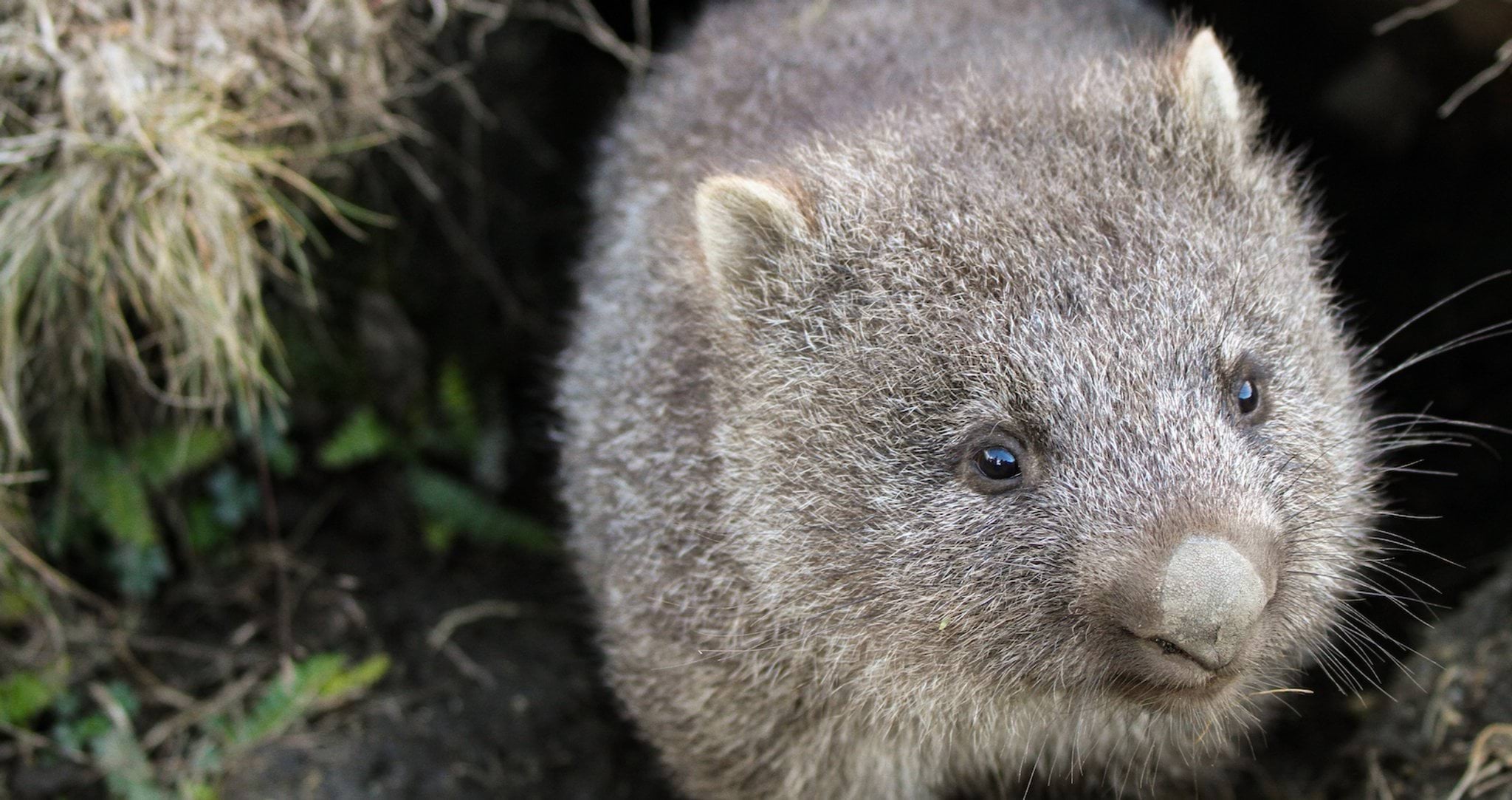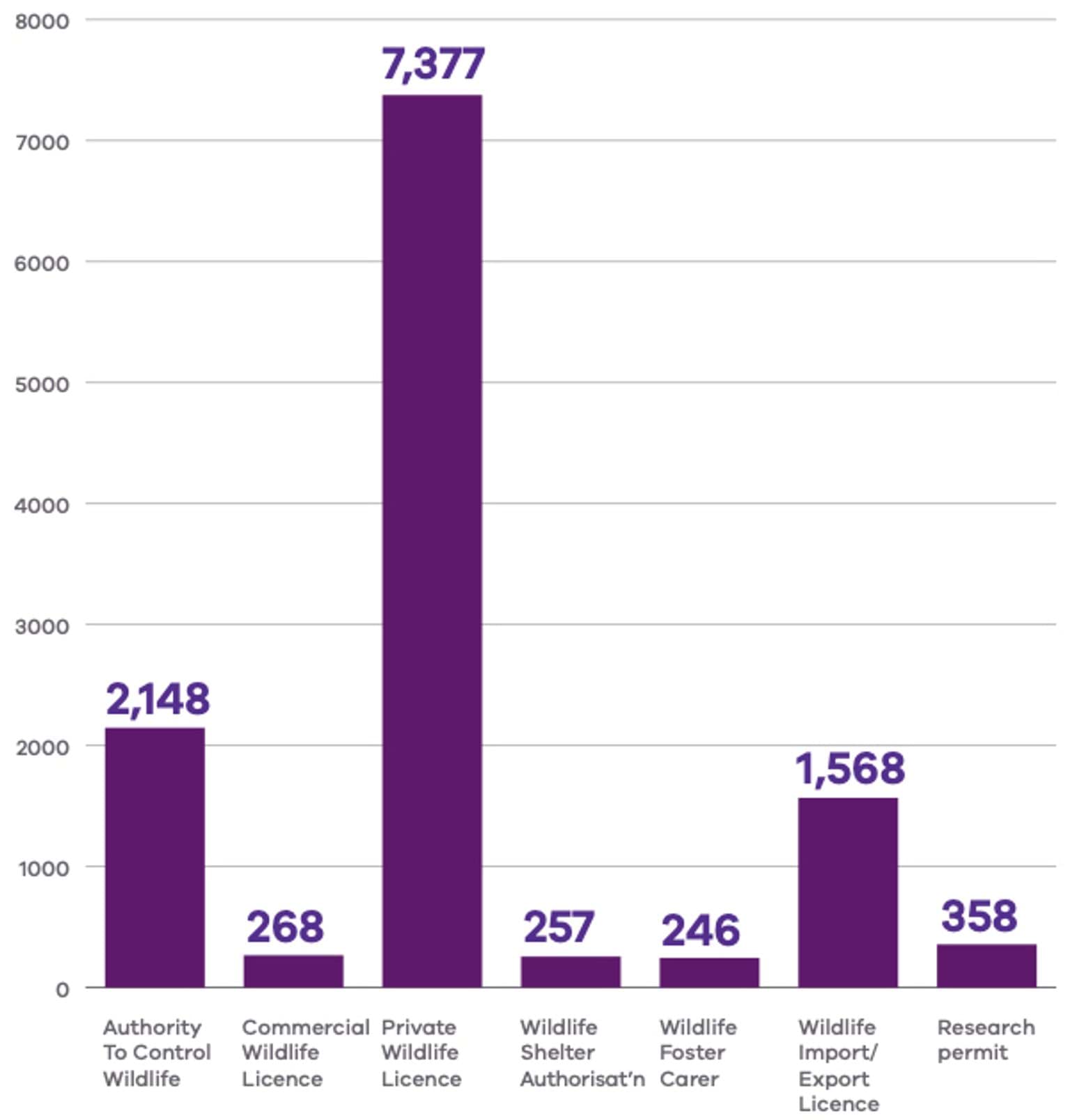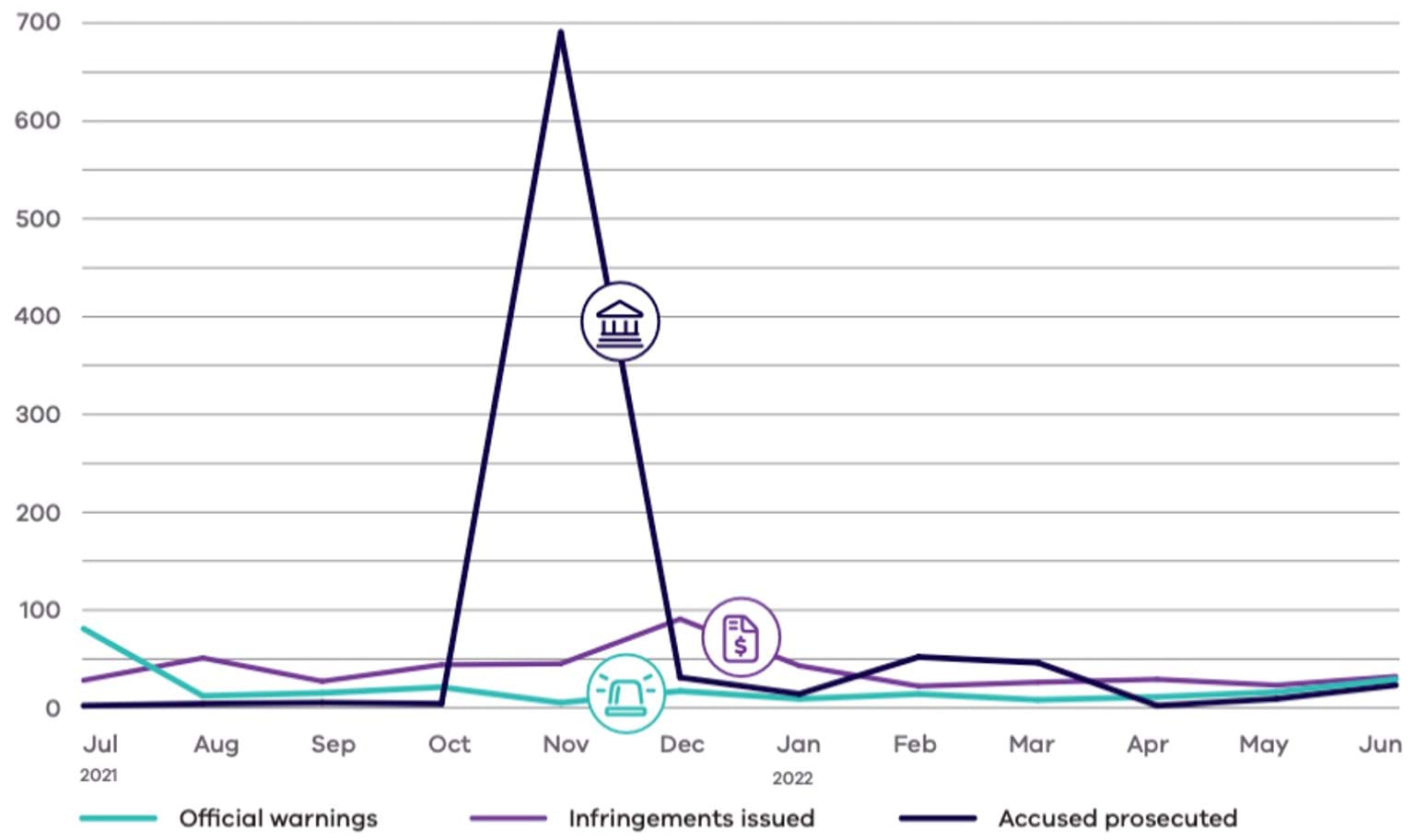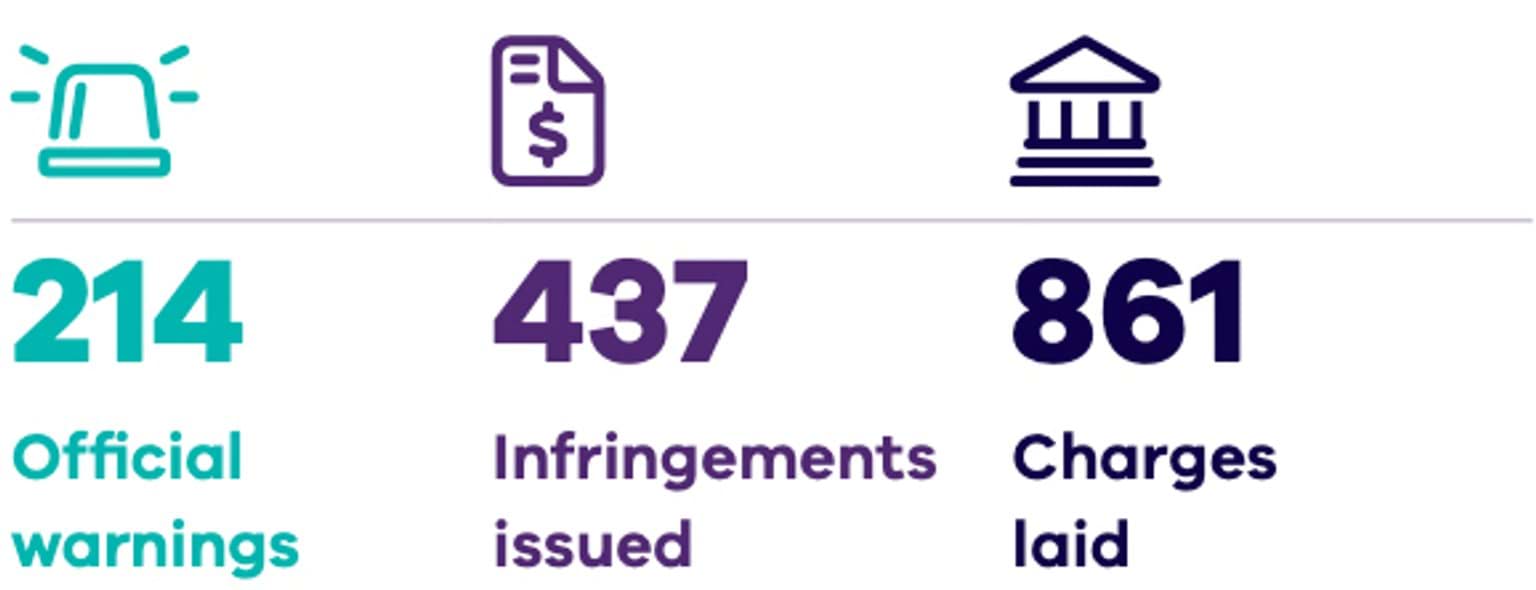In 2021-22 we continued our commitment to regulating in a way that is risk-based and intelligence-led, whilst engaging with the community to improve compliance with the law.
Illegal campfires
The Conservation Regulator continued to prioritise the safety of communities and the protection of the environment from devastating impacts of bushfire by reducing risks from illegal and unsafe campfires.
In 2021-22, more Victorians accessed public land closer to home for recreational purposes including camping, and with this there was widespread use of campfires. Our Authorised Officers conducted over 800 patrols of public land in partnership with Forest Fire Management Victoria to detect illegal campfires, inform and educate people on the laws, and where necessary take enforcement action when non-compliance occurred.
Whilst the weather conditions caused by La Nina reduced the risk associated with unattended campfires, the potential harms to the environment and community from illegal campfires remains.
We also partnered with our co-regulators in undertaking an ongoing education program to raise awareness of campfire regulations and safety. This was delivered through media campaigns, customer centres and during patrols.
Officers detected 532 unattended or abandoned campfires from July 2021 – June 2022, compared to the 800-plus illegal campfires detected in the previous year, a reduction of 39% (over 340 campfires). Illegal campfires were most commonly reported across the Hume and Gippsland regions, comprising approximately 79% of the total illegal campfires reported.
There were 16 prosecution charges laid relating to illegal campfires, including 8 on days of Total Fire Ban.
Through sustained community engagement and education, the Conservation Regulator is seeing a decline in the number of illegal campfires across the state over time.
lllegal possession of wildlife
The Conservation Regulator has an important role in the protection of Victoria’s unique wildlife, which involves identifying, investigating and prosecuting those responsible for crimes against wildlife.
Each year, many animals are unlawfully taken from the wild, for the illegal trade market, or personal use. Animals that are illegally trafficked can suffer due to the often-cruel methods used to transport them across borders, whilst those that are illegally kept may not be appropriately cared for. Removal of wildlife from natural environments can result in permanent damage to habitat (e.g. through the removal of rocks or hollows), and place additional stress on fragile ecosystems, as well as adversely impacting wildlife populations.
In 2021-22 there were 284 prosecution charges laid relating to wildlife. This includes both illegal possession and unlawful harm of wildlife.
This year, we undertook a range of activities to tackle the illegal possession of wildlife:
- We continued to work with Crime Stoppers Victoria and the Department of Jobs, Precincts and Regions to raise awareness of wildlife crime. A coordinated media campaign, called Break the Chain, was launched in October 2021 to raise public awareness of wildlife trafficking and encouraging community members to report information on wildlife crime to Crime Stoppers. In the year leading up to the campaign, there was a 59% increase in wildlife crime-related tips made to Crime Stoppers Victoria. All these reports help us build a picture of wildlife crime and undertake investigations where there is sufficient evidence. We thank the public for these reports and urge you to continue coming forward.
- We continued to take focused action against illegal wildlife tracking in partnership with the Federal Department of Climate Change, Energy, the Environment and Water (DCCEEW) and Australian Border Force via Operation Birmingham (see breakout box). Prior to international borders closing due to COVID-19, there was a drop in the illegal movement of wildlife across borders, which is likely due in part to the work of previous operations targeted at wildlife trading. However, recently surveillance and intelligence activities have uncovered an increase in movement of wildlife across state and territory borders, and internationally as borders have reopened.
- We undertook an inspection blitz of wildlife licence holders to ensure they are keeping their wildlife within licence conditions. Fifty-nine randomly selected wildlife licence holders were inspected, and about 30% of licence holders were found to have been non-compliant against the conditions of their licence. The non-compliances identified were related to incomplete or non-compliant record keeping practices and were addressed through educational advice provided to licence holders. Findings from operations like these allow us to direct future regulatory efforts to areas that will provide the greatest benefit to our wildlife.
Koalas at Cape Bridgewater
In December 2021, following a Conservation Regulator investigation beginning in February 2020, the owner of a Cape Bridgewater property and two companies were charged with 253 animal cruelty offences for allegedly clearing the property.
The man and businesses are accused of clearing habitat which impacted more than 200 koalas, including at least 70 which were injured and killed or had to be euthanised. The landowner and a forest and earthmoving business each face 126 charges under the Prevention of Cruelty to Animals Act 1986 and the Wildlife Act 1975, including 18 aggravated cruelty charges for causing fatal injuries. A separate contracting business was also charged with one cruelty offence under the Prevention of Cruelty to Animals Act 1986 for disturbing the koalas. The cases are still before the Portland Magistrate Court. We will continue to update the community with developments.
Six months in jail for man who committed animal cruelty crimes
A Trafalgar man was jailed for six months over disturbing wildlife cruelty offences towards common wombats, eastern grey kangaroos, brush-tailed possums and Sambar Deer.
The man was convicted last year and re-sentenced in February following an appeal, which included jail- time, a $6,000 fine and a ban from owning or being in charge of a dog for four years.
The man admitted using Mastiff-cross dogs to hunt and kill common wombats, eastern grey kangaroos, brush-tailed possums and Sambar Deer over a 21-month period between 2018-20. He also admitted to illegally using a firearm on 12 occasions against Sambar Deer.
He pleaded guilty to 50 counts of cruelty and hunting offences under the Wildlife Act 1975 and Prevention of Cruelty to Animals Act 1986, including one count of aggravated cruelty for killing a protected Eastern Grey Kangaroo.
He also pleaded guilty to a further three charges for offences committed under the Forests Act 1958 and Land Conservation (Vehicle Control) Regulations 2013.
Table 1 Performance measures for regulating the protection of wildlife
|
Performance measure |
Total |
|
|
Number of Wildlife Permissions by type issued |
Authority to Control Wildlife permits |
2,148 |
|
Commercial Wildlife Licences |
268 |
|
|
Private Wildlife Licences (including Dingo licences) |
7,377 |
|
|
Wildlife Shelter Licences |
257 |
|
|
Wildlife foster carer licences |
246 |
|
|
Wildlife import/export permits |
1,568 |
|
|
Research permits |
358 |
|
|
# or % proportion of Wildlife Licence Holders that submitted their required annual return |
47% |
|
|
Number of licence, permit and property inspections conducted to determine compliance with conditions |
148 |
|
|
Number of times Infringement Notices issued and number of prosecutions commenced in response to non-compliance, in line with the Conservation Regulator Compliance and Enforcement Policy |
Infringements issued |
28 |
|
Prosecution cases heard in the courts |
18 |
|
|
Number of contacts received and assessed by our Customer Contact Centre concerning wildlife |
4,645 |
|
Permits and licencing
There are many difference licences and permits issued by the Conservation Regulator. These help to ensure that when people interact with our wildlife, they do it carefully, ethically, sustainably, and in a way that meets the requirements of the Wildlife Act 1975.
We have continued to improve the way we assess and issue permits and licences including digitising application forms for Authority to Control Wildlife, Import and Export permits, and private wildlife licences.
Each year the number of Authority to Control Wildlife permits we issue varies and can be heavily influenced by environmental conditions. In 2021-22, higher rainfall and increased posture growth led to more native animals impacting upon agricultural land. This is likely to have have been a factor that led to an increase in the number of applications for Authority to Control Wildlife permits.
Licence and permit holders are subject to permit conditions and must meet these obligations. We provide education about obligations at the point of application and during renewals. We work to monitor compliance with licence and permit conditions, and non-compliances are pursued as part of our licence compliance activities. We also field hundreds of enquiries each year that come via email, or through the Customer Contact Centre.
Permit and licence types
There are many different licences and permits issued by the Conservation Regulator. They help to ensure that when people do interact with our wildlife, they do it carefully, ethically and sustainably. Permissions that we are responsible for include:
|
Private wildlife licence |
Allows people to keep wildlife as pets. |
|
Commercial wildlife licence |
Allows for the commercial use of wildlife, including selling wildlife in pet shops, keeping wildlife in zoos, as well as taxidermy and other processing of wildlife products. |
|
Authority to control wildlife |
For landholders and land managers who have issues with wildlife causing damage to buildings, pastures, crops or other property, or which pose risks to human health and safety. An authority may include permission for lethal and non-lethal control methods. |
|
Forest produce licence |
Allows individuals and private companies to cut, dig and take away material from state forests for personal or commercial use. |
|
Research permit |
Required for all wildlife in any research capacity, for instance attaching radio collars to track wildlife, or taking genetic samples from wildlife. |
|
Wildlife shelter or foster carer licence |
Required for the care and rehabilitation of injured or orphaned wildlife. |
International wildlife trafficking, Operation Sheffield
Our biggest wildlife trafficking investigation, Operation Sheffield, was conducted in 2018-20 in partnership with DCCEEW and Australian Border Force.
The lessons from this operation have led to some major improvements in stopping the illegal trade of Australian reptiles and other native animals before they are trafficked overseas.
Members of the public can now provide information on suspected wildlife trafficking through Crime Stoppers Victoria’s new dedicated ‘Wildlife Crime’ portal, which sends tips to our Intelligence Unit. The lessons we learned are being implemented in our ongoing operations and we are continuing to develop a proactive information sharing relationship with DCCEEW.
Five people have now been convicted following Operation Sheffield, with two prosecuted by the Conservation Regulator. In November 2021, a Werribee wildlife keeper was convicted and sentenced to a 12-month Community Corrections Order after Conservation Regulator Authorised Officers found a collection of more than 200 reptiles in terrible condition.
Officers executed a search warrant on the man’s house in 2019 and discovered reptiles that were dead and severely injured due to inadequate enclosures, food and water, and lack of veterinary treatment. His records were also inaccurate, a breach of the conditions of his wildlife licence.
Most of the animals in his possession had been taken from the wild. He was found guilty of offences under the Wildlife Act 1975, Wildlife Regulations 2013 and Prevention of Cruelty to Animals Act 1986.
Illegal commercial timber harvesting
Conservation Regulator is responsible for regulating native timber harvesting in state forests.
This is a complex role and requires a multi-faceted regulatory approach that involves undertaking proactive inspections and investigations, gathering intelligence, audits and responding to reports of non-compliance. The approach undertaken and outcomes for 2021-22 are detailed further in the Regulating timber harvesting chapter.
Timber harvesting regulation changes
There are now clearer, more enforceable rules for timber harvesting under the Sustainable Forests (Timber) Act 2004, with the Forests Legislation Amendment (Compliance and Enforcement) Act 2021 now in effect.
The changes clarify liability for offences under the Sustainable Forests (Timber) Act 2004. Powers to put in place enforceable undertakings and injunctions have been refined, and the Regulator has new powers to compel the production of certain documents to monitor compliance and assist in the conduct of investigation. The statute of limitations for prosecutions under the Act is also extended, from two years to three.
For the first time, timber industry contractors can also be liable for offences under the Sustainable Forests (Timber) Act 2004, and in 2022 the Conservation Regulator engaged with contractors and industry associations to help them understand their legal obligations. Information days were held at Bairnsdale, Traralgon and Marysville, where details on the changes to the law were shared with workers and employers.
Our Authorised Officers will continue to ensure enforcement action taken is in line with the harm caused. The Conservation Regulator’s approach to compliance and enforcement is described in our Compliance and Enforcement Policy.
Illegal take of firewood
The illegal take of firewood for personal use or in commercial quantities leads to the destruction of habitat, and the Conservation Regulator took concerted efforts in 2021-22 to tackle this persistent illegal activity.
Reports of illegal firewood collection tripled in 2021-22 from 2020–21 levels. This increase is the result of multiple factors, including improved detection and reporting, increased demand for firewood as a result of the increased costs of heating homes, and depletion of firewood stocks due to major bushfires.
In Victoria, there are designated firewood collection areas which provide the Victorian community with a legal source to collect from during two firewood collection seasons per year.
Preventing the destruction of habitat is critically important at a time when wildlife populations and ecosystems are still recovering from bushfire, and while climate change is leading to extreme weather events and overall hotter and drier conditions.
In 2021-22 there were 257 illegal firewood prosecution charges laid. We continued to refine our approach to reducing the environmental harm caused by the illegal removal of firewood from Victoria’s public land. Operation River Gum was a crucial collaborative enforcement operation, with key partner agencies including Parks Victoria and Victoria Police (see breakout box for more information).
Through more than 800 proactive patrols on public land associated with Operation Guardian, we engaged directly with members of the public, including many who were collecting firewood, providing an important opportunity to share information and educate the community about the law.
An advertising campaign via radio, in newspapers and online including on Facebook and Gumtree commencing in the Autumn firewood collection season in 2022, was highly successful in informing the community about how to comply with the relevant firewood requirements.
Amendments to the Forest Act 1958 (which took effect 1 May 2022) make it easier to understand and apply the law when people illegally remove timber and other forest produce by creating consistency for these offences across the state. Infringement notices can now be issued and penalties for these illegal actions in State Forests have been increased to align with penalties for similar actions in National Parks.
Operation River Gum
Through Operation River Gum we are continuing to develop and trial new operational methods to target illegal firewood collection in areas of greatest risk to both the environment and cultural values.
The areas of focus are primarily along the Murray, Goulburn and Loddon River corridors, with an emphasis on commercial levels of illegal firewood removal.
Concealed cameras have resulted in identifying and prosecuting individuals operating commercial scale operations on areas of public land. The seizing of chainsaws, trailers, vehicles, a light truck and timber has assisted in the effort to disrupt and deter those individuals who choose to undertake this activity. The locations selected for camera installations have both high biodiversity and cultural heritage values, which reflect the Conservation Regulator’s continued focus on targeting its resources to where the greatest protection is needed.
Our compliance and enforcement activities wouldn’t be complete without community engagement. To date we have engaged with almost 100 local firewood sellers, asking for their help to reduce the frequency of illegal firewood removal from the public land estate.
This is a joint project between the Conservation Regulator, Parks Victoria, Traditional Owners and the DELWP’s Forest Fire Operations Division. Operation River Gum will form a basis for future firewood based compliance activities across the state to ensure our efforts and resources are aligned with targeting the activities that result in high levels of environmental harm.
Buying firewood ads
We rely on members of the public for information about non- compliance. In June, we advertised educational messaging on Gumtree and Facebook Marketplace targeting people looking to purchase firewood in Victoria over winter.
The purpose was to encourage buyers to try and understand if firewood for sale had been sourced legally, by asking the following questions of their supplier:
- Where does your wood come from?
- Can I get a receipt?
- Why is the wood so cheap?
If a buyer was unable to get answers to these questions, they were encouraged to report this information to us on 136 186.
We chose Gumtree and Facebook Marketplace because these digital platforms are popular places for firewood trade.
The ads coincided with a state-wide media and social media campaign, which reached more than 130,000 people.
Illegal vehicle use
An increase in off-road activities on public land has been driven by population growth, increasing numbers of visitors to public land associated with the pandemic, and the lower cost of recreational vehicles.
Illegal vehicle use on public land usually involves driving off-road on walking tracks, through the bush or areas closed to the public. It damages the environment and cultural sites, spreads soil- borne pathogens and poses a safety risk to those engaging in illegal behaviour. Environmental damage is also being witnessed as the result of the illegal construction of both mountain bike and trail bike trails.
In 2021-22 there were 21 prosecution charges laid relating to off-road vehicle use on public land. Key sites of offending included in Barwon South West and Gippsland, where off-road trail bike use was a key offence.
The Conservation Regulator has undertaken targeted operations at key sites across the state to identify offenders. We use several investigation methods, including patrols, encouraging community reports and the use of concealed surveillance cameras on public land.
The Conservation Regulator operates a Trail Bike Initiative which seeks to promote safe, legal and environmentally sustainable trail riding practices within the community of approximately 60,000 licenced trail bike riders with registered trail bikes. These riders are authorised to access over 30,000km of roads and formed vehicle tracks in State forests, with additional riding opportunities in State parks.
More than 30% of Victoria’s reported motorcycle crashes occur on these roads, and in addition, significant environmental damage can result if the motorcycles are illegally operated off the formed road network.
Safety and environmental protection concerns have grown during the past two years due to the significant increase in the number and frequency of people going trail bike riding. Federal Chamber of Automotive Industries data show that during the COVID-19 pandemic, sales of off-road motorcycles increased by 30.3% during 2020 and 54.9% during 2021 compared to 2019.
This increase has been driven by growing community interest in taking up informal outdoor recreation and has been enabled by greater disposable income for many because of travel and other leisure activities being curtailed. The long-term legacy is that there are going to be more riders and more trail bikes in Victoria's forests in the future.
Through the Trail Bike Initiative, the Conservation Regulator works with road safety partners (Victoria Police, Department of Health, Transport Accident Commission, Department of Justice and Community Safety and Department of Transport) and motorcycle associations to promote safe riding practices.
The Conservation Regulator now has more than 40 accredited staff who conduct trail bike mounted patrols across all State forests. Conversation Regulator trail bike officers attend trail bike events across the State to promote the awareness and use of Personal Locator Beacons (PLBs) as an aid to summon emergency medical support in the event of a serious crash.
Summary of enforcement action
Charges laid increased in November this year as some of our biggest operations reached the court system. This included cruelty charges laid over the deaths and injuries of koalas near Cape Bridgewater and habitat destruction charges for a public land clearing case near Mildura.
Figure 3 provides a month-by-month breakdown of the number of warnings and infringements issued and number of accused prosecuted.
Fines for clearing native vegetation
We have seen some record results in the Victorian courts this year, with two public land clearing cases brought by the Conservation Regulator receiving convictions and the highest penalties ever handed down for our cases.
Criminal convictions and significant fines were handed down on two of our large-scale clearing investigations.
Two men were convicted and fined $25,000 each, for the destruction of more than eight hectares of wildlife habitat near Mildura, and in the state’s southwest, a farmer was convicted and ordered to pay nearly $60,000 for destroying habitat in the Annya State Forest, near Heywood.
Both cases occurred on public land neighbouring the offenders’ properties, and in both cases the respective Magistrate said the offenders should have known better.
As the regulator of public land in Victoria, it’s our responsibility to investigate and prosecute cases of illegal native vegetation removal on Crown land
Updated








